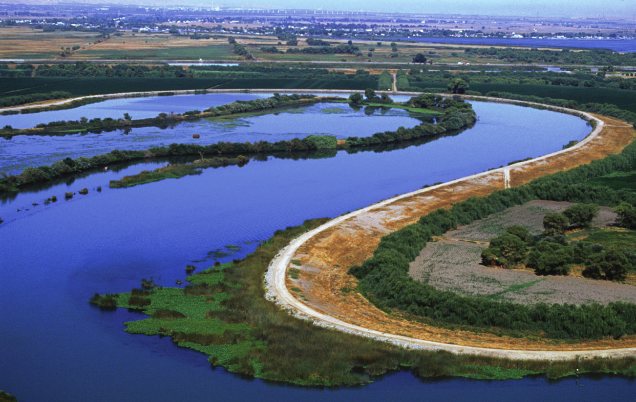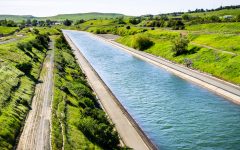
California Bay Delta water (Photo: USGS.gov)
Ringside: More Water Supply Requires Industry Unity
Rationing is expensive, destroys entire industries, drives businesses and residents out of state, and prevents homebuilding
By Edward Ring, September 4, 2024 2:30 pm
 Probably the most consequential and controversial water policy decisions in California involve how much water to pump out of the Sacramento-San Joaquin Delta and into southbound aqueducts, and we’re in the middle of another one right now.
Probably the most consequential and controversial water policy decisions in California involve how much water to pump out of the Sacramento-San Joaquin Delta and into southbound aqueducts, and we’re in the middle of another one right now.
For the last several years, as summer turns to fall, state and federal regulators reduce the amount of water that gets pumped south in order to help the Delta smelt, an endangered fish. This year is no exception. In what is referred to as the “Fall X2 Action,” the pumps are about to be throttled down again. Water agencies at the receiving end claim the reduction, set to last about two months, will cost them up to 400,000 acre feet.
The reason the state wants to let this much water escape into the San Francisco Bay is to improve habitat for the endangered smelt, but critics of this strategy claim that smelt haven’t been found in the area, making the action fruitless. They also claim that regulators have the authority to restore higher rates of pumping without requiring a protracted bureaucratic process.
To learn more details, refer to an excellent recent report by Don Wright, “Fall X2 Line.” It not only explains the immediate situation, it provides background information for anyone unfamiliar with the agencies and regulations involved.
Meanwhile, this situation invites some strategic questions that ought to dominate water policy dialogue in California, but don’t.
1 – Why does state water policy continue to assume more flow through the delta will cause endangered and threatened species to rebound, when despite 20 years of continually escalating restrictions on water withdrawals, they can point to almost no positive results?
2 – When will the state recognize the role of introduced predators that feed on salmon and smelt, and either remove limits on fishing these predators, or abandon efforts to save the weaker native species?
3 – How can the legislature justify the estimated $7 billion cost to impose strict water rationing on every urban resident in the state in order to save 400,000 acre feet per year, when simply allowing the delta pumps to operate normally in September and October would supply an equivalent amount?
4 – Why is the state unwilling to invest in practical water supply infrastructure that could eliminate water scarcity forever?
To that last question, our capacity to harvest storm runoff during the winter and spring storms is only limited by our lack of appropriate infrastructure, along with an apparent penchant to invest billions in low yield schemes such as urban water rationing.
For example, during the first three months of 2024, an astonishing 10.3 million acre feet flowed through the delta and out to the ocean. In the first quarter of 2023, the total was 13.3 MAF, whereas in Q1 of 2022, a dry year, only 2.0 MAF made it through to the ocean. When are we going to build the capacity to take the so-called “big gulp”? Imagine if we had pulled an additional 2-3 MAF out of the delta during both of those very wet winters.
Here’s another question: When are state regulators, the activist staff members who prepare all the expert reports the regulators choose to rely on – and the ridiculously well-funded activist environmentalist NGOs that keep a watchful eye on everything they do – going to realize that the delta will never be the same?
Once levees channelized most of the delta over a century ago, and dry islands were formed, the peat rich soils in these islands were exposed to the atmosphere and shrunk as they dried out. It is impossible to restore the delta because the elevation of these islands are now up to 25 feet below sea level. If you tried to restore the delta, you would not turn it back into a delta. You’d turn it into a bay.
Similarly, unless you can eliminate every introduced alien species, from Atlantic bass to Asian clams, you can kiss goodbye many of the native aquatic life. The delta habitat and the mix of species that inhabit it are changed forever, and more flow in October and November isn’t going to make much difference in its ultimate fate.
To turn around a regulatory apparatus fixated on rationing, California’s water agencies and water consumers would have better luck if they would agree on and aggressively promote specific, practical policy options. Collectively investing in the fish friendly delta diversions concept is an example of potentially game-changing infrastructure. It would involve creating a channel in an existing delta island, lining the bottom, and burying perforated pipes underneath a bed of gravel to withdraw fresh water during storms. With no impact to either current or fish, a 200 acre site could yield 15,000 acre feet per day.
Two or three of those installations, sending water into the San Joaquin Valley’s capacious aquifers for storage, would solve water scarcity in California forever, at an estimated cost of $3.0 billion. There are other supply side solutions: wastewater recycling, urban storm runoff harvesting, desalination. That’s another 2-3 MAF per year, rain or shine.
If a supply mentality informed water policy, it would no longer be a zero sum game. Rationing is expensive, destroys entire industries, drives businesses and residents out of state, and prevents homebuilding. Rationing is annoying if not downright tyrannical, and it dangerously undermines resilience. In the milieu of scarcity it sustains, it even takes away options for the environment.
Collective effort by water agencies and farming interests should not be impossible if one goal is paramount: We need a regulatory environment and a capital spending plan that will result in new sources of abundant water. Piecemeal lobbying and litigation has failed. Unity, on the other hand, could make all the difference.
- Ringside: Finding Water for the San Joaquin Valley - December 5, 2024
- Ringside: Californian Energy Use Compared to the USA and the World - November 29, 2024
- Ringside: The Numbers Driving California vs. Washington on Energy, Water & Forestry - November 21, 2024





Always glad to see these practical — and often innovative — water policies from Edward Ring on the record. Looks like, however, we’re going to need new, sensible, and earnest leadership, and a brand-new set of bureaucrats — or even better a radical thinning of bureaucrats —- before we can hope to see the suggested policies implemented. As it is now, it sure as heck seems as though the more we need common sense from leadership, the more they are determined to dig their heels in, hell-bent for destruction and tyranny. Hoping for the serious and unified efforts of water agencies and farming interests in the meantime, as Edward Ring recommended.